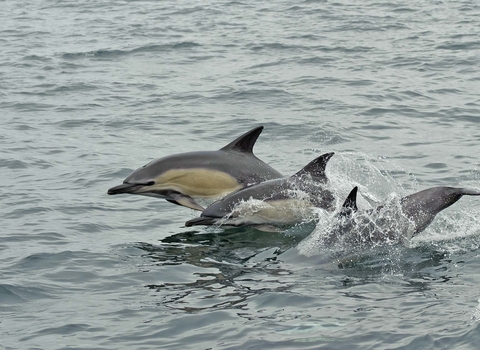
Common Dolphins ©Chris Gomersall/2020VISION
Common dolphin
Scientific name
Delphinus delphisWhen to see
January to DecemberSpecies information
Category
Statistics
Length: up to 2.7m Weight: up to 150kg Average Lifespan: up to 35 yearsHabitats
About
Common dolphins (also referred to as short-beaked common dolphins) are an offshore species but often come close to shore to feed. They are highly social and normally found in groups, travelling at speed and frequently leaping from the water. They feed mainly on fish and will work together to herd their prey into a ball.How to identify
A slender dolphin, they are dark grey above and whiter below. Common dolphins have a distinctive hourglass pattern on their sides, including an obvious yellow-cream area starting behind the long, narrow beak. The dorsal fin is tall and triangular and curves slightly backwards.Distribution
Found all around the UK, most common off South and West coasts and offshore.In our area
Scilly's seas abound with wildlife, including a variety of cetacean species including common dolphins, harbour porpoises, minke whales and even bigger species like humpback and fin whales. One of the best ways to see marine mammals is to watch from Scilly's many headlands (like Peninnis or Deep Point on St Mary's, Wingletang on St Agnes, Shipman Head Down on Bryher, Castle Down on Tresco or from the Daymark on St Martin's) or to head out on a WiSE accredited boat operator offshore. Cetaceans don't generally come between the islands, so a trip to the Western Rocks, Eastern Isles or beyond will give you the best opportunities to see them. You can also spot plentiful wildlife on the Scillonian III crossing from Penzance with Isles of Scilly Travel.
Sometimes common dolphins form huge groups known as superpods, with several hundred animals all cruising along at once. Look beneath diving gannets and big flocks of gulls for a chance to spot fins breaking the surface beneath - both birds and cetaceans will make the most of big shoals of fish or bait balls.
Did you know?
Common dolphins are fast! They can reach swimming speeds of around 30 miles per hour when chasing food or bowriding alongside boats.Scilly's seas abound with wildlife, including a variety of cetacean species including common dolphins, harbour porpoises, minke whales and even bigger species like humpback and fin whales. One of the best ways to see marine mammals is to watch from Scilly's many headlands (like Peninnis or Deep Point on St Mary's, Wingletang on St Agnes, Shipman Head Down on Bryher, Castle Down on Tresco or from the Daymark on St Martin's) or to head out on a WiSE accredited boat operator offshore. Cetaceans don't generally come between the islands, so a trip to the Western Rocks, Eastern Isles or beyond will give you the best opportunities to see them. You can also spot plentiful wildlife on the Scillonian III crossing from Penzance with Isles of Scilly Travel.
Sometimes common dolphins form huge groups known as superpods, with several hundred animals all cruising along at once. Look beneath diving gannets and big flocks of gulls for a chance to spot fins breaking the surface beneath - both birds and cetaceans will make the most of big shoals of fish or bait balls.
